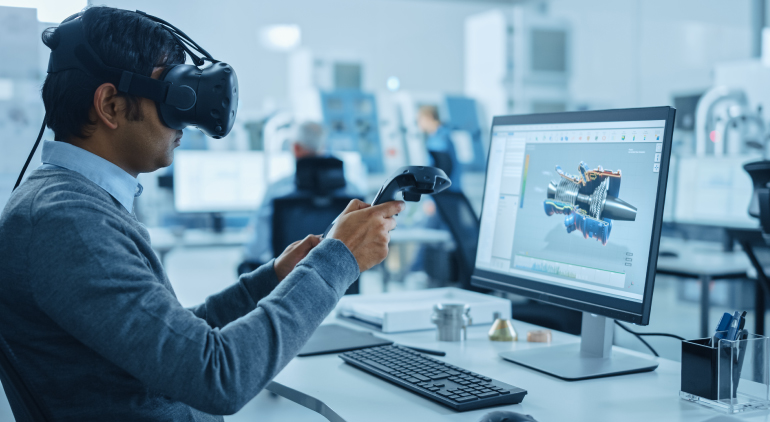Virtual Reality has progressed rapidly in use across industries recently. Its adoption has expanded beyond the conventional use of gaming and entertainment. Its benefits are many, and all sectors have realised its value. From education to healthcare, VR has become a normal and common fixture.
If we talk about the education sector, VR is helping to reshape pedagogies and transform how content is learnt and taught. In the higher education sector, its uses and applications are truly transformative. The benefits of skill mastery, higher learning outcomes and confidence are the “tip of the iceberg” benefits of VR labs.
VR in Engineering
VR in engineering is driving experiential learning, meeting the demands of the emerging knowledge economy and helping to create a technologically ready workforce. There are many roles and benefits of VR in the engineering sector, and institutes are capitalising on the novel technology. VR labs in engineering offer simulated 3D environments that allow immersive learning. This is extremely useful for engineering students. It exposes them to real-life work situations and allows them to apply their theoretical knowledge. Engineering students can work with hazardous materials, chemicals etc., in a risk-free setting and conduct experiments repeatedly to arrive at justified conclusions. The 3D environment enables students to master their skills and develop higher self-confidence in execution.
Learner’s confidence level rises by almost 40% more in VR training than in classroom training.
Students who use VR-based learning systems train four times faster than those in classrooms.
Medical and Engineering students are availing the benefits of any time and anywhere learning. They are not constrained by geographical and physical boundaries. They are leveraging the benefits offered by VR labs to communicate and collaborate with peers and mentors worldwide.
VR Labs are also an asset. They follow a scalable model and do not incur additional costs with every use. In traditional labs, students are normally grouped together to perform experiments etc. This does not allow every learner to practice individually. Moreover, there are restraints in terms of equipment and materials. VR Labs successfully remove these hurdles allowing intensive learning solutions.
The AEC industry is poised to take advantage of VR Solutions. In this post, we will detail out the uses and benefits of VR is enabling innovation in the AEC industry.
VR in AEC
Virtual reality (VR) is proving to be a boon for companies specialising in AEC solutions. It is also reorienting how students are learning the architectural and engineering concepts. It is taking forward on Building Information Modelling to bring in new and efficient work models. VR offers a hassle-free route to avoid planning and execution building errors. The improvements are not only qualitative but also quantifiable, and deploying VR enhances ROI.
As per a Capgemini study, companies using VR reported an increase of 10% in operational benefits.
Real-time Rendering
Traditionally, AEC engineers had limited visuals of their creation in a 2D atmosphere. This was the case even with 3D CAD. Visualising their creations as it would look in the real world was an abstract concept. To make changes in the blueprint was again a tedious and non-imaginative process. However, VR and 3D rendering allow architects to visualise their designs in real-time and as they would look in the real world. . They can view, visit and walk through and make changes as required in real-time renderings. The technology has proved to be a boon and allowed creativity to flourish with accelerated delivery timelines.
Client Satisfaction
Using VR allows designers and clients to be on the same page in real-time. Meetings can be held remotely, and all changes can be seen and accepted in real-time. It eliminates the need to travel. Designers can better explain their creation about all design elements like space, aesthetics, light etc. Clients can track the progress and suggest changes as per their needs and desire.
Accessibility and Safety Designs
VR allows building owners to understand the proposed solutions. Advisors can assess the safety parameters and accessibility designs for wheelchair users etc. Operation rooms can be checked out in the planning stage and necessary changes made.
Accelerated Projects
With VR, engineers and clients get a full immersive 1:1 experience of the project. It’s no longer an abstract version but a simulation of the real-world project. Proposals are executed faster, and decisions are taken in real-time.
In fact, a report published on the blog structure mag reports that VR achieved a 90% reduction in decision-taking time for healthcare construction projects.
Wrapping Up
The AEC or Architecture, Engineering and Construction Industry is warming up to VR engineering deployment. Its use as an advanced design tool redefines the BIM model and new ways to visualise and collaborate. Construction safety can be addressed and included in the planning stage rather than as an afterthought. 3D manipulations help engineers to avoid pitfalls later on.

